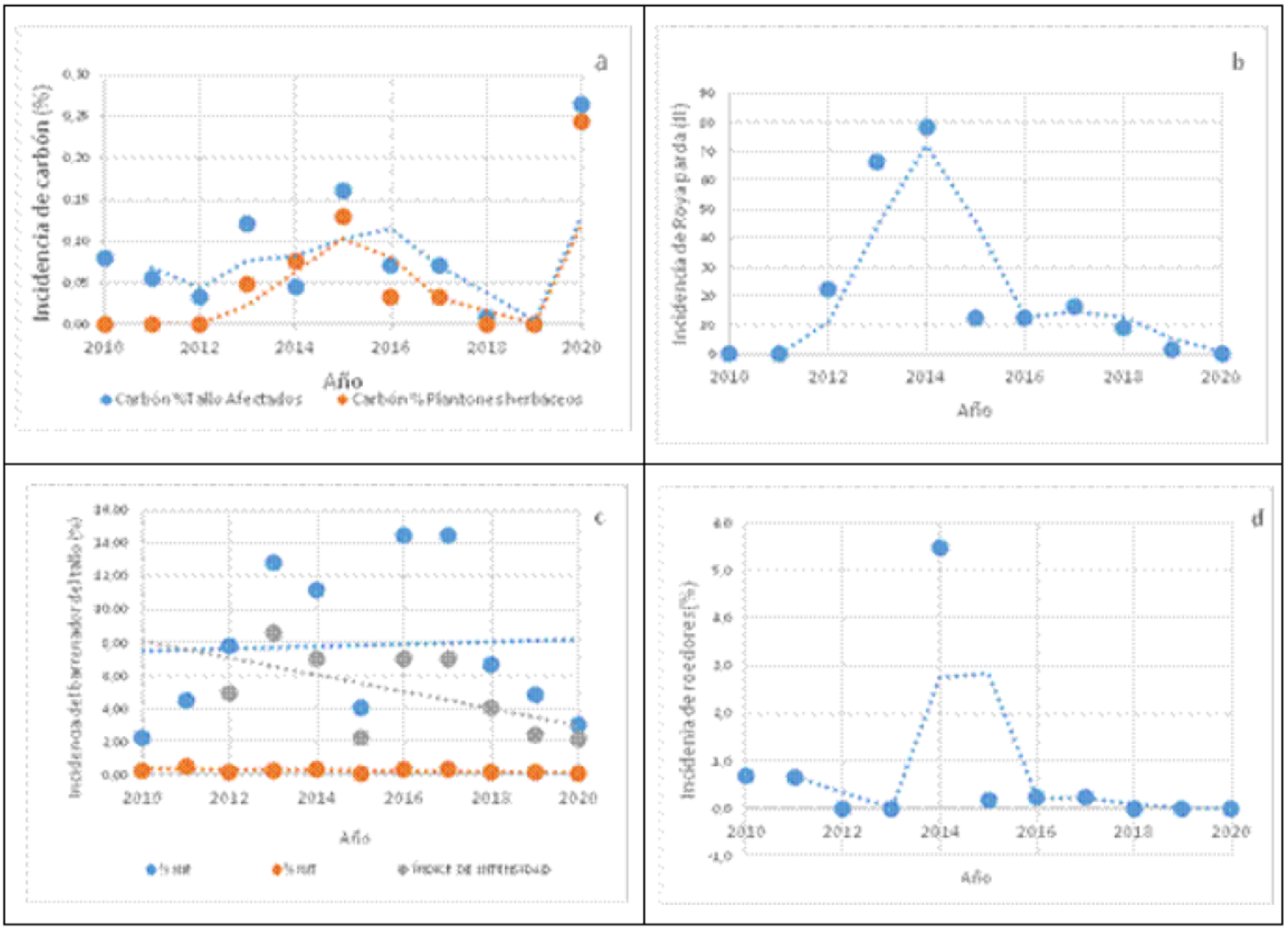Incidence of pests in the cultivation of sugar cane in the Cooperativa de Producción Agropecuaria Dagoberto Rojas
Main Article Content
Abstract
A case study was carried out for the analysis of the pests in the sugar cane crop and the factors that influenced their performance in the grower’s farm Dagoberto Rojas, based on the information generated by the application of the Plant Protection Service. The main result of the study reflects the presence of smut, brown rust, borers, defoliators, leafhoppers and rodents, without records of leaf scald, mosaic and elaterids in the areas of the farm during the years 2010-2020. It was considered that the situation in relation to pests was favorable in the farm, given its low incidence in the period analyzed, despite the predisposition of exhibiting a composition of varieties that provides a high percentage of areas occupied with varieties susceptible to four of the main pathologies of the crop. The greatest contribution to brown rust infection was made by blocks 0601, 0603, 0608 and 0607, while blocks 0601, 0602 and 0603 contribute to borer infestation. The management measures applied in relation to the releases of Lixophaga diatraeae contributed to the decrease the incidence of the borer, which shows the efficiency of the recommendations, so it is recommended to continue with them, as well as to adopt a management of the composition of varieties with a greater presence of genotypes in favor of increasing resistance, to protect the incidence levels of brown rust, cald, mosaic and smut.
Article Details

This work is licensed under a Creative Commons Attribution-NonCommercial 4.0 International License.
References
Anwar, M. S., Khan, H. W. A., Muhammad, M., Chattha, A. A., & Amjad, Z. (2010). Integrated control strategies for sugarcane disease. Pakistan Sugar Journal, 25(2), 7-9.
González, R., Carvajal, O., Montalván, J., Alfonso, F., Rodríguez, J., & Rodríguez, M. (2015). Resistencia a enfermedades de la caña de azúcar en Cuba. Criterios y Estrategias. 2132, 4pp., XII Congreso Internacional sobre Azúcar y Derivados. Diversificación 2015, La Habana, Cuba.
González, R., Carvajal, O., Montalván, J., Rodríguez, J., Alfonso, F., Rodríguez, M., & Fuentes, A. (2015). Resistencia a enfermedades de la caña de azúcar en Cuba: Criterios y estrategias. Revista de Protección Vegetal, 30, 152-152.
Jiménez, A. L. (2019). Procedimiento para determinar el factor de pérdida inducido por Diatraea saccharalis en caña de azúcar [Tesis en Opción al Título Académico de Máster en Ciencias en Sanidad Vegetal. Mención: Sanidad Vegetal]. Universidad Agraria de La Habana “Fructuoso Rodríguez Pérez”, Facultad de Agronomía, San José de las Lajas, Mayabeque, Cuba.
La O, M., Mesa, J. M., Verdecia, A., La O, D., Montalván, J., Carvajal, O., Rodríguez, J., Alfonso, I., Zardón, M. A., & Rivera, M. J. (2012). Software SC-RESIST (Versión 372-2012) [Computer software]. Centro Nacional de Derecho de autor, La Habana, Cuba.
Pérez, Y. (2018). Bases para el manejo de la escaldadura foliar de la caña de azúcar en Cuba [Tesis en Opción al Título Académico de Doctor en Ciencias Agrícola]. Universidad Agraria de La Habana “Fructuoso Rodríguez Pérez”, Facultad de Agronomía, San José de las Lajas, Mayabeque, Cuba.
Ramesh-Sundar, A., Ashwin, N. M. R., Leonard-Barnabas, E., Malathi, P., & Viswanathan, R. (2015). Disease resistance in sugarcane-An overview. Scientia Agraria Paranaensis, 14(4), 200-212.
Rodríguez, M., Rodríguez, E., Alfonso, I., & Acevedo, R. (2013). Servicio Fitosanitario para la Caña de Azúcar (SEFIT). Manual de procedimientos. Publiinica, La Habana, Cuba.
